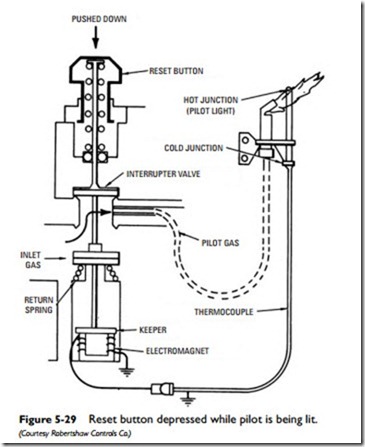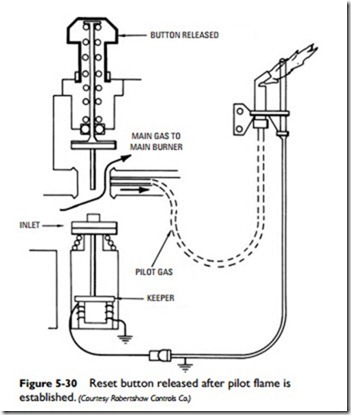Automatic Pilot Safety Valve
The automatic pilot safety valve is a device used to shut off the gas supply when the pilot flame is extinguished or fails to light.
There are a variety of different pilot safety controls available on the market, but all are based on one of the following three operating principles:
• Thermocouple
• Metal expansion
• Liquid pressure
Pilot safety controls based on the thermocouple operating principle are probably the most common. The schematic in Figure 5-27 shows the principal components of an automatic pilot in which a thermocouple is used. The constant-burning pilot of the system illustrated here provides not only burner gas ignition but also heat for the hot junction of the thermocouple. As shown in Figure 5-28, the hot junction of a thermocouple is positioned so that it is directly in the path of the pilot flame.
The thermocouple itself is actually a miniature generator that can convert heat (from the pilot flame) into millivolts of electricity. It consists of two dissimilar metals joined together at their extremities. When one of the junctions (the hot junction) remains cold, electrical energy is generated. The amount of energy generated by
the thermocouple is directly proportional to the temperature differ- ence between the hot and cold junctions (see Figure 5-28). One thermocouple or junction will deliver approximately 25 millivolts. Several thermocouples or junctions can be wired in series to pro- duce a higher voltage (see Pilot Generators). The electrical energy generated by the thermocouple energizes an electromagnet that operates the automatic pilot valve.
The automatic pilot safety valve may be an individual control but is more commonly a part of a combination control, which usually combines manual valve and thermostatic or automatic valve func- tions. These valves are described in this chapter (see Combination Gas Valves).
Some automatic pilot valves are designed to shut off both the main gas (i.e., the gas to the main burners) and the pilot gas. This is called 100 percent safety automatic pilot or a 100 percent safety shutoff. They are recommended for use with either natural or LP gases.
A 90 percent safety automatic pilot (or 90 percent safety shutoff) shuts off the gas supply to the main burners but allows gas to continue flowing to the pilot burner. This type of gas pilot may be used safely with natural gas (and is permitted by some local codes), but it should never be used with LP gas. LP gas is heavier than air and will not vent.
The procedure for lighting the pilot in a system containing a thermocouple (or pilot generator) and an automatic pilot safety valve is fairly simple. The reset button on the automatic pilot valve must be pushed down while the pilot is being lit (see Figures 5-29 and 5-30). While the reset button is depressed, an auxiliary valve causes the main gas porting to close. At the same time, the spring- loaded automatic pilot valve is opened, allowing gas to flow only to the pilot burner, which can now be lit.
The same action that opened the spring-loaded automatic valve has also forced the keeper (see Figure 5-29) against the pole faces of the electromagnet. Eventually the heat of the pilot flame causes the thermocouple to generate an electrical current, which causes the electromagnet to become magnetized. As a result, the keeper is held against the magnet and the automatic pilot valve is maintained in an open position. The pilot should be allowed to burn for at least 60 seconds before releasing the button. This permits enough current to
be built up by the thermocouple or pilot generator to hold the valve open.
Once the pilot has been established, the reset button can be released, and the main gas and pilot gas will be free to move past the automatic pilot valve (see Figure 5-30). When the pilot flame is extinguished, the thermocouple hot junction cools and breaks the electrical current. The electromagnet is demagnetized as a result of this loss of current, and the keeper is released, causing the automatic pilot valve to close and shut off the flow of gas. Before relighting the pilot, allow at least 5 minutes for all the gas to clear the system.



